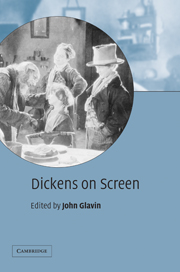Book contents
- Frontmatter
- Contents
- List of illustrations
- Notes on the contributors
- Acknowledgments
- Introduction
- Part I
- Part II
- Part III
- Part IV
- 11 Cinematic Dickens and uncinematic words
- 12 Dickens, Eisenstein, film
- 13 Orson Welles and Charles Dickens 1938–1941
- 14 David Copperfield (1935) and the US curriculum
- 15 Dickens, Selznick, and Southpark
- 16 Tiny Tim on screen: a disability studies perspective
- Part V
- Index
- References
13 - Orson Welles and Charles Dickens 1938–1941
Published online by Cambridge University Press: 22 September 2009
- Frontmatter
- Contents
- List of illustrations
- Notes on the contributors
- Acknowledgments
- Introduction
- Part I
- Part II
- Part III
- Part IV
- 11 Cinematic Dickens and uncinematic words
- 12 Dickens, Eisenstein, film
- 13 Orson Welles and Charles Dickens 1938–1941
- 14 David Copperfield (1935) and the US curriculum
- 15 Dickens, Selznick, and Southpark
- 16 Tiny Tim on screen: a disability studies perspective
- Part V
- Index
- References
Summary
In July 1938, Orson Welles introduced “First Person Singular.” In this CBS radio series he intended to wed the performance experimentation he had brought to the Federal Theatre Project with the income and commercial appeal that radio had consistently afforded him since his 1935 appearances in “March of Time.” Over the remaining months of 1938, he produced in “First Person Singular” four radio plays based on the work of Charles Dickens, A Tale of Two Cities (July 25), Oliver Twist (October 2), The Pickwick Papers (November 20) and A Christmas Carol (December 23). Dickens thus became Welles's most frequently adapted author in 1938 (Wood 1990: 92–7). In 1939, when he was lured to Hollywood with an RKO contract, it was widely expected that Welles would continue this practice of adapting the “classics” for the “masses,” and in 1940 rumors circulated about a pending production under his direction of The Pickwick Papers, to star W. C. Fields. This is the story of why that film never materialized.
“First Person Singular”
Following Dracula and Treasure Island, A Tale of Two Cities was the third text to be adapted by Welles in the series. It was an ideal choice for “First Person Singular,” since it both fulfilled Welles's interest in the collapse of narrated time and offered a variety of possibilities for experimentation with the retelling of the story in first-person singular.
- Type
- Chapter
- Information
- Dickens on Screen , pp. 145 - 154Publisher: Cambridge University PressPrint publication year: 2003
References
- 3
- Cited by



